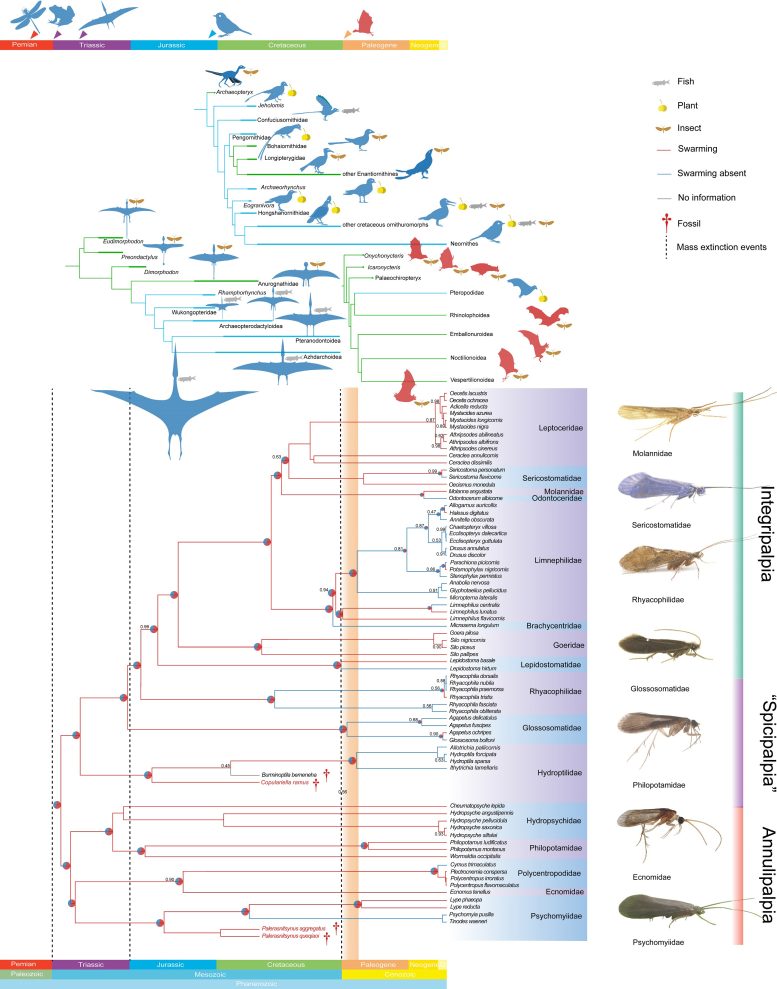

Caddisfly swarming behavior, identified from mid-Cretaceous amber, may have diminished in response to the rise of echolocating bats.
A new study reveals that swarming behavior in caddisflies likely began in the Triassic but was frequently lost around 50–53 million years ago due to predation from echolocating bats, which the insects could not detect.
The research was led by Professor Dong Ren and Dr. Jiajia Wang (College of Life Sciences, Capital Normal University). The obvious aggregations, a large gathering of adult caddisflies, were found in six small mid-Cretaceous Kachin amber pieces.
The Mid-Cretaceous swarming of Trichoptera is identified according to the results of Principal Component Analysis based on the morphological traits of wing shape, as well as other morphological evidence such as the presence of sexual dimorphism and the extended phalli of males.
Evolutionary Origins of Swarming
Results of a phylogenetic reconstruction of both molecular and morphological data as well as ancestral-trait reconstructions and tip-dating analyses indicate that swarming was likely present in the Triassic as a feature of the trichopteran groundplan.

In order to reconstruct patterns of swarming during trichopteran evolution, the team took a Bayesian Evolutionary Analysis Sampling Tree based on 30 morphological characters and six molecular sequences. In this analysis, they selected 79 trichopteran species from 15 families, which include the major superfamilies and swarming groups. Swarming behavior was reconstructed as a synapomorphy of Trichoptera based on the ancestral trait reconstruction.
Loss of Swarming Behavior
The researchers also found that many trichopteran families lost swarming behavior about 50–53 million years ago. This episode of time is critical as it was coeval with the rise of echolocating bats. Tympanic organs and other sound-detecting organs of similar attunement have not been present in extant or fossil Trichoptera, so the caddisflies cannot detect bat ultrasound.
This phenomenon shows that the presence of echolocating bats resulted in significant pressure on swarming Trichoptera, and it was possible that this was a contributing factor to the repeated loss of swarming behavior by various trichopterans during the Eocene, representing a strategic response to bat predation. Although birds and pterosaurs were the major small-flying predators from the Mesozoic, they seemingly had little impact on swarming because most Mesozoic flying insectivorous predators were also diurnal while the swarming began mainly after dusk and peaked before midnight.
This study shows a correlation between the rise of nocturnal bat predators from the Paleocene or Early Eocene and the repeated loss of swarming from various clades of caddisflies, revealing the potential impact of bat predation on reshaping the behavioral landscape of Trichoptera during the Cenozoic. Trichoptera diversity appeared to have fallen behind that of their sister group, the Lepidoptera, during the Cenozoic, and this might have partly been a result of novel predator pressures such as those imposed by the rise of bats.
Reference: “Swarming caddisflies in the mid-cretaceous” by Jiajia Wang, Michael S Engel, Weiting Zhang, Chungkun Shih, Rui Qiu and Dong Ren, 28 June 2024, National Science Review.
DOI: 10.1093/nsr/nwae227